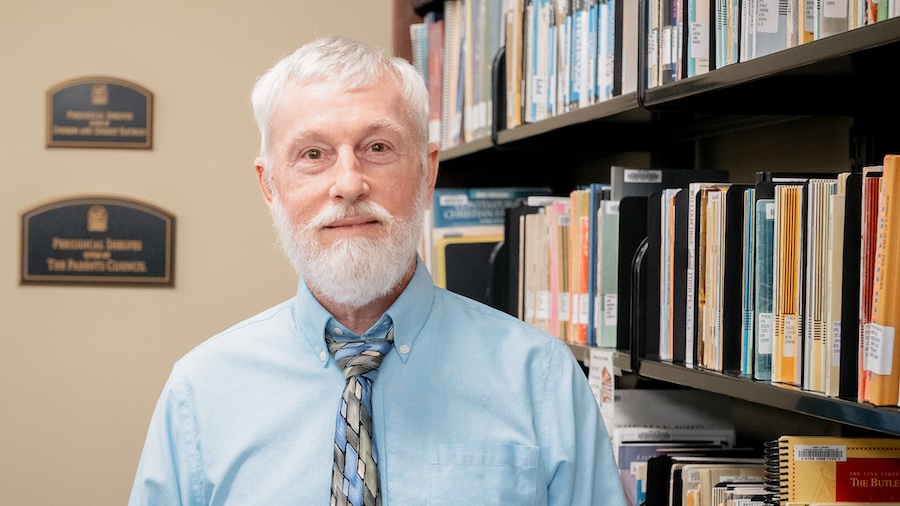As Kent Millwood looks back on 34 years of directing Thrift Library at Anderson University, he says his top accomplishment has been staying in front of change. That in itself is no small feat, considering everything that’s happened in the years since.
During Millwood’s time at Anderson, the university has grown into the largest private institution in South Carolina and the library itself has moved across campus and transformed into the state-of-the-art Thrift Library. During those years, the library has transitioned from card catalogs to computers, and from thousands of volumes of books to virtually limitless digital resources. More importantly, the library has moved from simply being a storehouse of information to a dynamic hub of research activity and group projects.
After earning a bachelor’s degree in broadcasting, Millwood began his career working at a television station in his hometown of Chattanooga, Tennessee. From there he moved to Dyersburg Community College where he was a media specialist. Then he interviewed for and accepted a position as library director/media specialist at his alma mater, Hiwassee College. Millwood had been a student worker there before graduating, so he had some familiarity with libraries. But he said he had his master’s in the wrong field—education, with an emphasis in learning resources. Millwood went on to earn his masters in library science while on the job.
“It was a bit of a gamble to become a library director with no experience and not bomb at it. I was a little bit worried,” said Millwood. “I took to it, I’ve stuck with it and it’s been a good career.”
Although Anderson had about a thousand students when Millwood arrived, he saw it as a positive next step for his career.
“It was a pay raise and an opportunity to have more resources and work on a bigger stage. Anderson had a really good reputation,” said Millwood. “We were at a transition period for libraries where the big universities were getting automated. They had gotten rid of their card catalogs and so forth long before, but the smaller colleges, particularly two year and independent faith-based colleges, were well behind making the transition; so when I arrived, we had a card catalog, we had zero computers.”
From today’s point of view, the past seems light years away. As he gives library orientations to students, Millwood compares the size of the physical collection (books, periodicals and other paper resources) to Earth and the digital resources to Jupiter. He compared the laborious process of poring through thick bound periodical indices and hundreds of drawers of index cards to a search that today’s students can perform in the palm of their hands.
“Today you take a topic and you get a million hits. Back then, if you were doing a very specific topic, you struggled to find 10 resources,” Millwood said. “Interlibrary loan is basically infinite. Anything we don’t have we can get. It’s just mind boggling what’s available to us now compared to the old days.”
Millwood recalled that when he began his career, libraries were basically like islands.
“Now, every academic library in South Carolina is connected into one automated system. Not only do we share a system but we share assistance, where we help each other and we delegate work among us and share the work so that instead of 56 libraries doing the same thing, one library does it for the entire state and then some other library does something else for the entire state. It makes us much more effective than we have been in the past.”
Even technology constantly changes to keep pace with demand, according to Millwood. A goal early on was to put an overhead projector in every classroom. As good as computer technology was when it arrived, the rows of computers that helped patrons find books and other resources eventually disappeared from the library floor. The library established its own website that offers ever-expanding resources available online. As one of few Apple Distinguished Schools in the nation, Millwood notes that every Anderson University student is issued an iPad—a powerful resource for them to use over the next four years.
In 2007, the library moved from the location in Johnston Hall that they had outgrown many years before, to the newly constructed Thrift Library. In 2017, Thrift Library underwent more renovations to keep pace with ever-changing demand.
Millwood’s wife Linda is an Anderson University graduate and helped edit a book on former president Annie Dove Denmark. All of his children are Anderson University graduates as well. One of Millwood’s retirement projects is to continue writing individual storybooks for his grandchildren as well as nephews and nieces.
Anderson University will honor Millwood December 12, 2022 with a university-wide reception.
About Thrift Library
In addition to housing library collections and resources, Thrift Library also contains the Vandiver Gallery, a space for rotating visual arts exhibitions. Upstairs is the AU Center for Cybersecurity’s lab, the Center for Student Success and the Writing Lab. Downstairs is the home of the AU Center for Information and Digital Learning (AU CIDL), which includes a state-of-the-art makerspace; AU Professional and Lifelong Learning; Anderson’s Information Technology Department; Books n’ Beans, a popular student gathering spot that serves coffee beverages and snacks; the campus post office and classroom space. Details can be found online.

